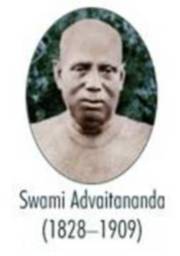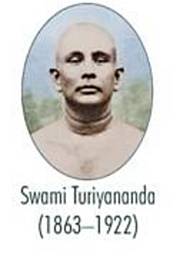Swami Advaitananda in his pre-monastic days was known as Gopal Sur. He was the oldest of the monastic disciples of Sri Ramakrishna. He was older than even the Master by a few years. Because of his age Sri Ramakrishna would address him as “aged Gopal,” and the devotees and disciples of the Master would call him GopaldzL or Gopal the older brother. He was bom in a village a few miles to the south of Calcutta but usually he lived in Sinthi near Calcutta. Gopal was an employee in a shop in Chinabazar, Calcutta, belonging to Beni Pal of Sinthi. Beni Pal was a devout Brahmo, and in the religious celebrations which he performed at his place the Master would also occasionally be present. Perhaps it was at these meetings that Gopal first met the Master. Gopalda’s version of one of these religious festivals at the house of Beni Pal was that the Master sang devotional songs and performed an ecstatic dance with so much enthusiasm and for such a long time that his body got heated and he jumped into an adjacent pond to cool himself. As a consequence he got a severe cold which resulted in the throat sore and throat cancer to which he finally succumbed.
Gopalda was a married man. At the death ofhis wife he had received such a great shock that he did not know what to do. A friend, who was a devotee of the Master, asked him to go to Dakshineswar, which he did. On the first visit Gopalda was not very impressed by the Master nor did he find anything very remarkable in him. But his friend insisted on his repeating the visit, for holy men do not often reveal themselves at once. Gopalda complied, and this time he was caught in the love of Sri Ramakrishna. As he began to frequent Dakshineswar, the overwhelming burden of his grief was completely removed. The Master’s simple explanation of the unreality of the world made a deep impression on his mind, and he began seriously to think of giving up the world in search of God. Ultimately he renounced the world and devoted himself heart and soul to the service of the Master in his last illness. He was very neat and clean and the embodiment of method and orderliness. These traits in him received great appreciation from the Master.
One day Gopalda expressed a desire to the Master to distribute some ochre cloths and rosaries to monks.- On this the Master replied: “You won’t find better monks than these young boys here. You may give your cloths and rosaries to them.” Thereupon Gopalda placed a bundle of saffron cloths before the Master, who distributed them among his young disciples. Thus was sown the seed of the future Ramakrishna Order.
At the Cossipore garden-house Swami Viveka-nanda, then Narendra Nath, when one day sitting in meditation, was lost to outer consciousness. His mind flew beyond the realm of relative consciousness and was merged in the Absolute. After a long while as he began to regain consciousness, Narendra Nath became conscious of his thought but not of his body. So he cried out, “Where has my body gone?” Hearing this strange utterance, Gopalda rushed to the spot and began to explain that his body was there. But as his words carried no conviction to Narendra Nath, Gopalda got terrified and ran to the Master for help. After some time Narendra Nath returned to his normal consciousness.
After the passing away of the Master, Gopalda had no home to go to. So with him as the first inmate was started the monastery at Baranagore. After staying in this monastery for a few years he went to Benares where he practised Sadhana for about five years. One who had the privilege of staying with him at Benares says that his regularity in spiritual practices was wonderful. Very early in the morning, even in the severe wintry days of Benares, he would get up and go to the Ganges for a bath. From there he would return shivering with cold but his mind absorbed in reciting some Sanskrit hymns. The programme of the whole day was fixed, and he would follow it without the least deviation for days, months and years. At Benares he lived on Madhukari, i.e., small quantities of cooked food collected from various houses, so that it might not be taxing to a single individual. Adjacent to a place where an image of Shiva was installed, he occupied a small room. But how neat and clean that small room was ! Everything kept in its proper place: the room at once gave indication of great taste and orderliness. His steadiness would cause wonder to those who watched him. He was quite indifferent to worldly sights and sounds, and followed his own tenor of life in the contemplation of the Divinity from day to day without any break.
When Swami Vivekananda returned to India and organised the Ramakrishna Brotherhood, Swami Advaitananda, the name he was given when he became a monk, returned to the Math at Alambazar. Afterwards he stayed mainly at the new monastery at Belur Math. He looked after the management of various affairs of the monastery, specially the garden work. But all work he undertook or supervised had to be done very systematically and with scrupulous care. The young novitiates could hardly rise to his standard of perfection as regards work, and for that reason they had a very hard time with him. Many of them would receive mild rebukes from old Gopalda, but they would take his criticisms more as a token of affection than as any indication of bitterness. Gopalda, however, would say latterly: “The Master has shown me that it is He who is manifested through all. Then whom to blame or whom to criticise?’’ After this experience Gopalda ceased from finding fault with anyone however great might be the latter’s errors.
Even in his old age he was self-supporting.He would not like anybody to take the trouble of attending to his personal needs.
Being the most senior in age he was looked upon with affectionate regard by all his brother-disciples. But they also enjoyed making fun with him. Swami Vivekananda composed a comical verse in order to tease Gopalda, but that really indicated in what great esteem Gopalda was held by all.
Gopalda made strenuous efforts to mould his life according to the life and example of the Master, and would sometimes express disappointment that he fell so short of the ideal. But this feeling of disappointment indicated only his real spiritual height. Because of his age Gopalda did not engage himself in any public activity, philanthropic, missionary or otherwise, so his monastic life was quite uneventful. But so long as he was in the physical body, he definitely set an example to all, and he was the source of inspiration to many. His uniform steadfastness in Sadhana till the last days of his life elicited admiration, if not reverence, even from his brother-disciples. His love for truth was wonderful. He heard the Master say that one should not twist truth even to make fun. Gopalda obeyed this instruction to the letter and the spirit and insisted on others doing likewise.
He travelled extensively and visited, at one time or other in his life, sacred places like Kedar-nath, Badrinarayan and Hardwar in the North, Dwarka in the West and Rameswar and other places in the South. He kept sound health till the good old age he lived to. After suffering for some time from stomach trouble, he passed away on December 28, 1904, at the age of eighty-one.


